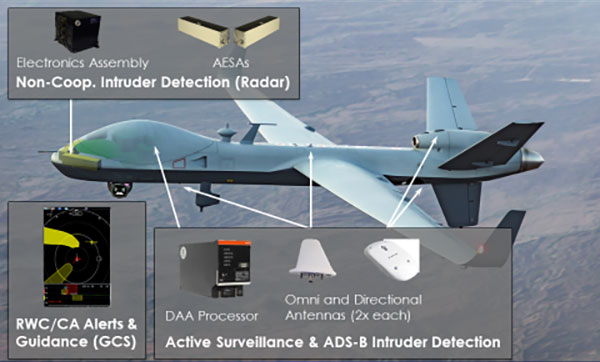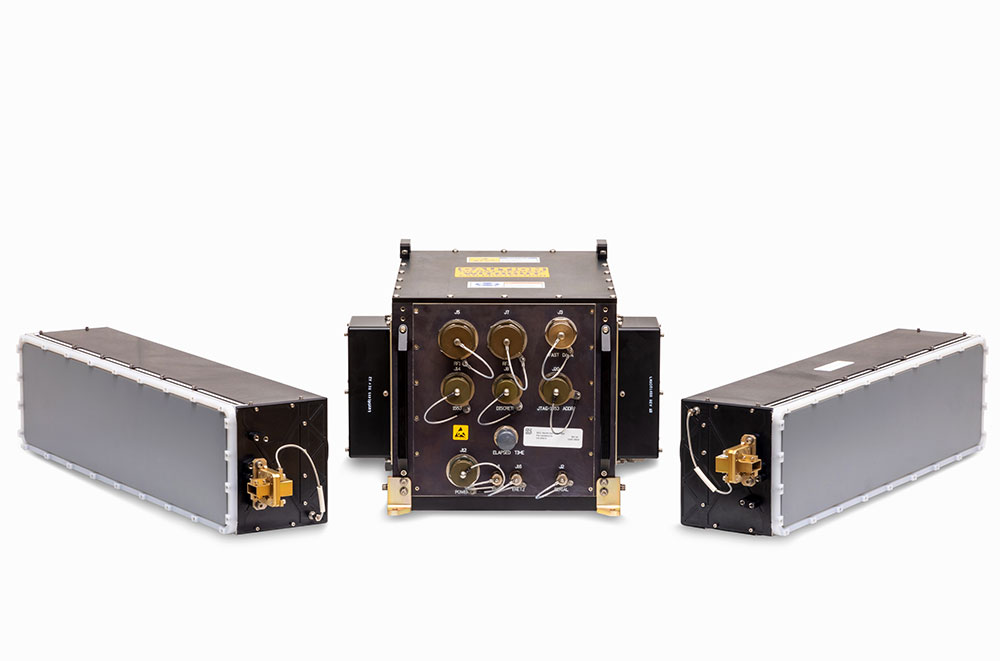Detect and Avoid System | General Atomics Aeronautical Systems Inc.
Detect and Avoid System
Essential Technology to Integrate Unmanned Aircraft Systems (UAS) into the National Airspace System (NAS)
As a leading manufacturer of Remotely Piloted Aircraft (RPA) systems, GA-ASI has been an industry leader in the efforts to advance technology and develop policy to facilitate the safe integration of RPA into National Airspace. One focus of these efforts is the inability for Unmanned Aircraft System (UAS) to meet the "see and avoid" requirements found in 14 CFR 91.113. These regulations describe a pilot-provided function that, for UAS, must be met using an alternative means of compliance, known as Detect and Avoid (DAA).

GA-ASI has been at the forefront of DAA technology development and standardization since 2011, when early prototypes of the GA-ASI Air-to-Air Radar (ATAR) were first produced and tested. With the formation of RTCA Special Committee 228 (SC-228) in 2013, GA-ASI began making critical contributions to the standardization of the technology through flight testing of the GA-ASI ATAR and a prototype DAA algorithm, developed by Information Systems Delft (ISD) and contracted to GA-ASI. These prototypes, in conjunction with the results from four NASA/GA-ASI flight test campaigns, served as building blocks for the Minimum Operational Performance Standards (MOPS) for DAA and ATAR that were released in Q2 of 2017: RTCA DO-365 and RTCA DO-366, respectively. Collaboration with Honeywell, ACSS, BAE Systems and multiple flights carried out on NASA's Ikhana were instrumental in achieving an industry-wide solution.
Later in 2017, these MOPS were adopted by the FAA into two Technical Standard Orders (TSOs) as the certification basis for DAA: TSO-C211 for DAA, and TSO-C212 for ATAR systems. Additionally, GA-ASI has actively participated in the standards development for the next generation of DAA Systems: Airborne Collision Avoidance System-Xu (ACAS-Xu), scheduled to be released in late 2020.
Alongside contributions to the standards development for DAA, GA-ASI has sparked several internal programs intent on furthering the integration of UAS in civil airspace. The first is a mature, fielded version of the aforementioned prototype system, known as the Baseline DAA system. With over 3,000 hours deployed onboard Customs and Border Protection's (CBP) MQ-9 aircraft since 2016, the design, support, and sustainment of the Baseline DAA system has established GA-ASI as a leader in the realm of DAA technology.
The Baseline DAA program has also provided insight and comprehensive experience to lay the groundwork for its subsequent project to create the world's first-ever certified DAA system. Efforts to design, build, and certify this DAA system began in 2018 and are expected to reach completion with a TSO-C211 and TSO-C212 authorization in 2022.
The certified system incorporates a TCAS II collision avoidance system, certified hardware and software, and represents the culmination of nearly 10 years of industry-leading DAA technology. The certified system is the key to complying with the "see and avoid" requirements in the U.S., and GA-ASI has a project planned to do the same for European airspace.
Upon release of the ACAS Xu MOPS, GA-ASI plans to develop an ACAS Xu DAA system, a DAA solution that was jointly developed by U.S. and European standards organizations (RTCA and EUROCAE, respectively). ACAS Xu signifies a joint solution to the largest technological barrier to civil airspace access for UAS, and is the key to international harmonization of DAA standards. This solution, along as the other GA-ASI DAA solutions, provide our customers and the industry with an ever-growing opportunity for safe airspace access for UAS.
Due Regard Radar

The Due Regard Radar (DRR) is an air-to-air radar being developed under company funding to meet the requirements envisioned to enable Remotely Piloted Aircraft (RPA) to fly in International Airspace. The DRR is comprised of a two panel Active Electronically Scanned Array (AESA) Antenna and a Radar Electronics Assembly (REA) that give the RPA pilot the ability to detect and track aircraft across the same Field-of-View (FOV) as a manned aircraft. AESA technology allows DRR to track multiple targets while simultaneously continuing to scan for new aircraft. Flight tests of a pre-production DRR are underway on both a manned aircraft and a Predator® B RPA.
DRR is a key component of GA-ASI's overall airborne Detect and Avoid (DAA) architecture for Predator B. The DAA system must detect and avoid cooperative (i.e. aircraft equipped with a transponder) and non-cooperative (i.e. aircraft not equipped with a transponder) aircraft. Detection and tracking of cooperative aircraft is performed by the Traffic Collision Avoidance System (TCAS) and Automatic Dependent Surveillance-Broadcast (ADS-B). By tracking non-cooperative aircraft, DRR enables a collision avoidance capability onboard the RPA and allows the pilot to separate the aircraft from other air traffic in cooperation with Air Traffic Control (ATC).
GA-ASI is currently partnered with the FAA, NASA, and several industry partners to mature a DAA capability onboard NASA's Ikhana RPA. The FAA is developing a collision avoidance algorithm specifically for RPA, called ACAS XU, which uses the GA ASI DRR to detect and track non-cooperative aircraft.
Features/Benefits:
- High-performance, actively electronically scanned array antenna
- Air-cooled antenna and radar electronics assembly
- Detects and tracks any aircraft in FOV regardless of equipment onboard
- Feeds tracks through DAA system to remote pilot
- Enables due regard operations in international airspace
- Facilitates full and safe integration of RPA into the U.S. National Airspace System (NAS)


No comments:
Post a Comment